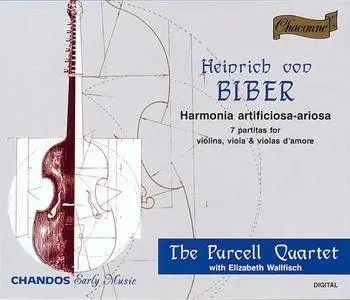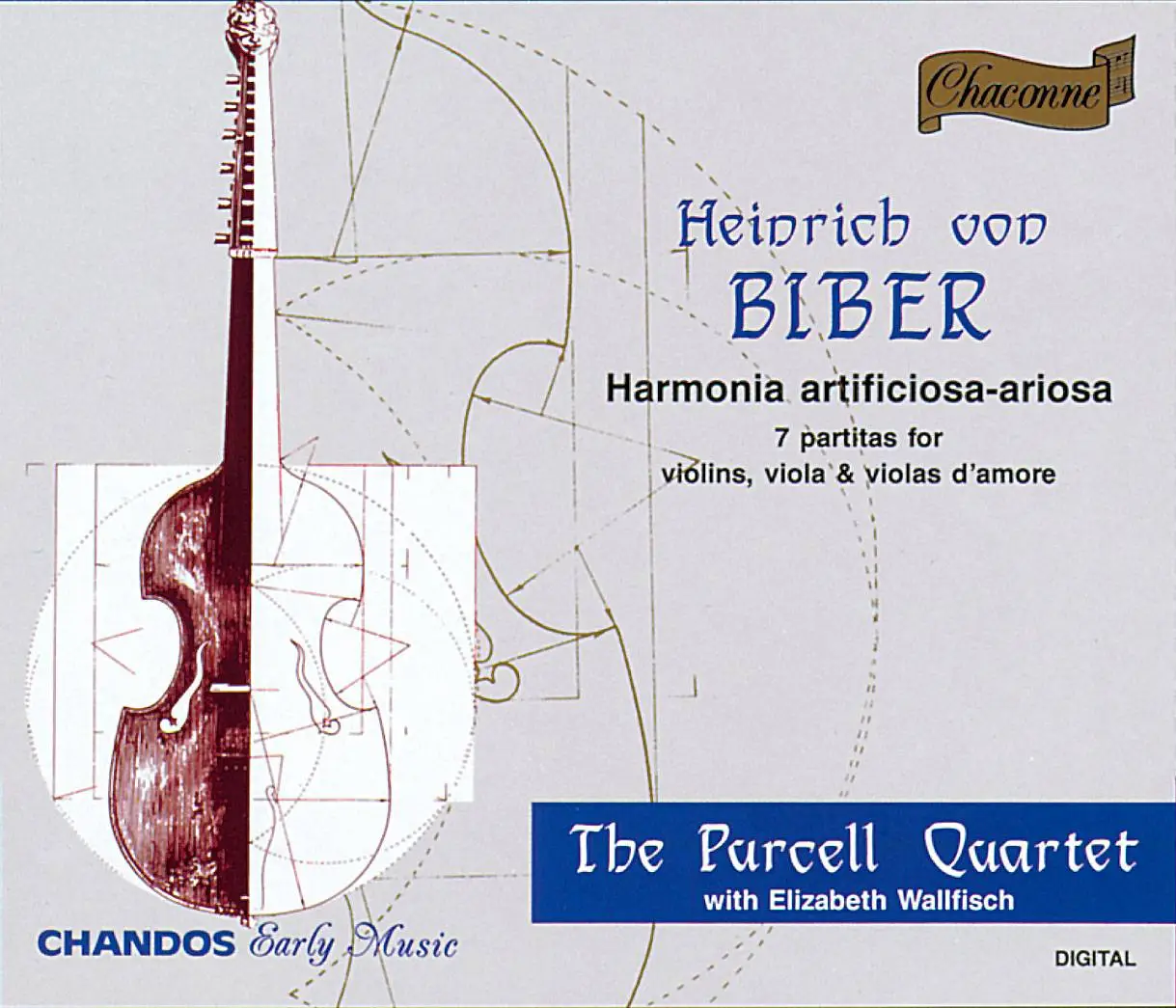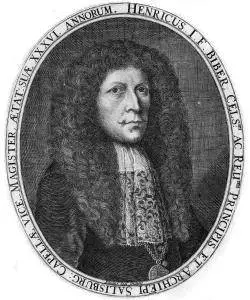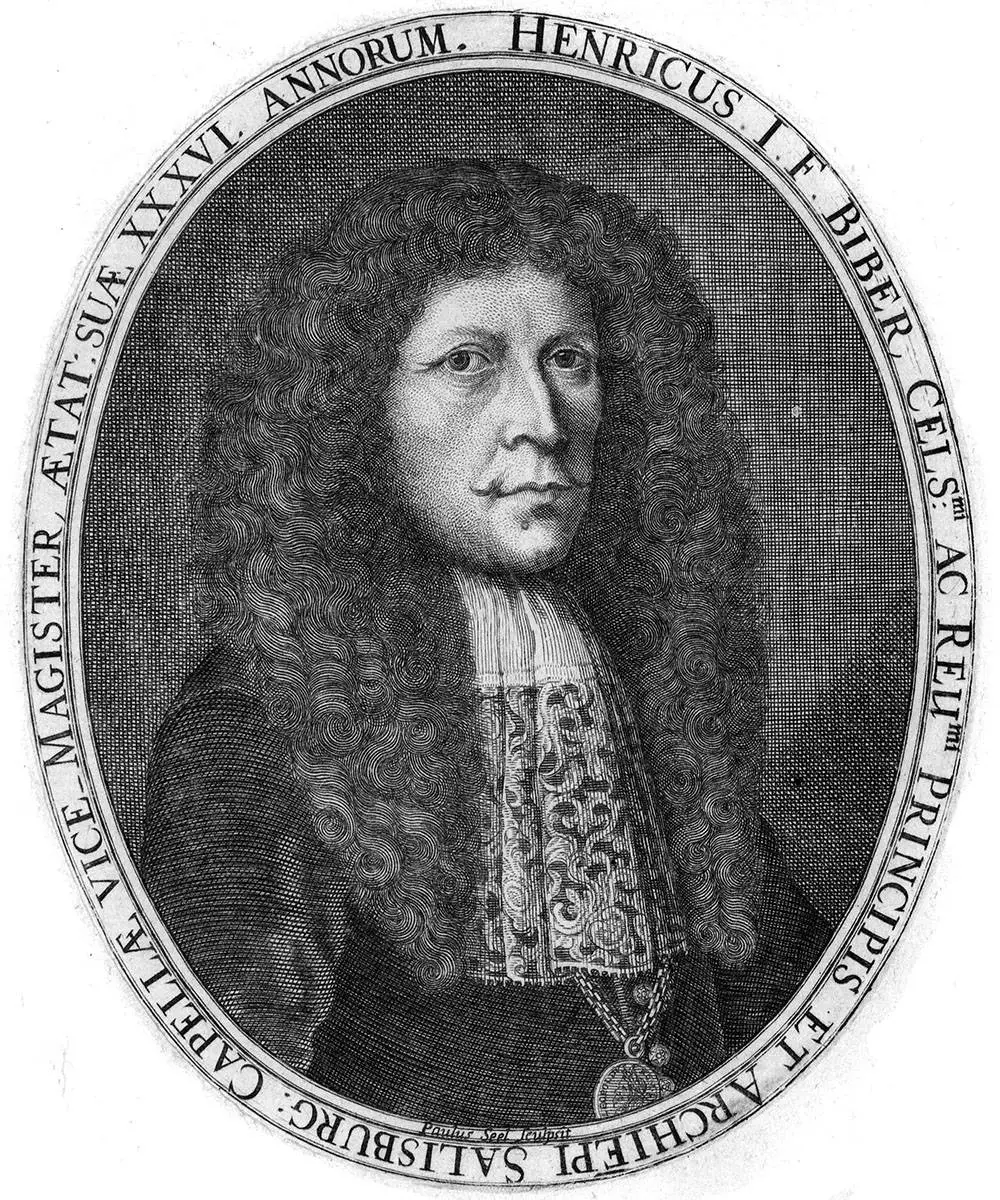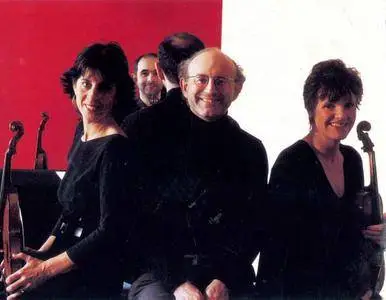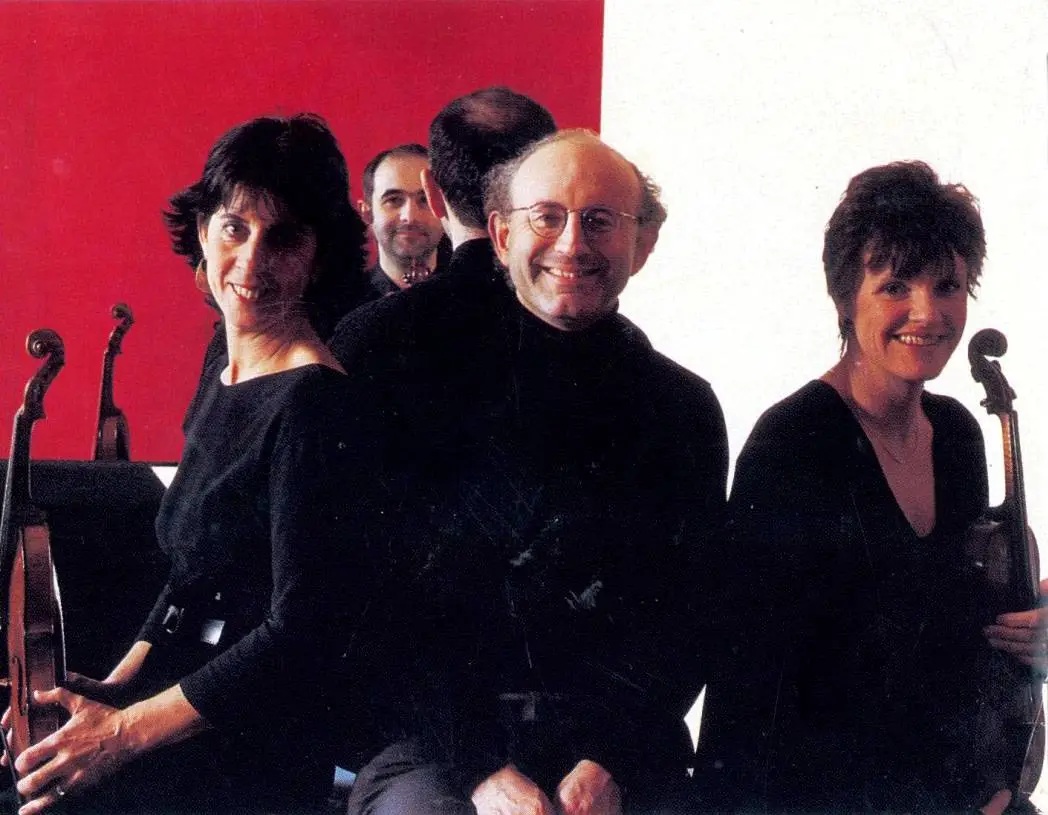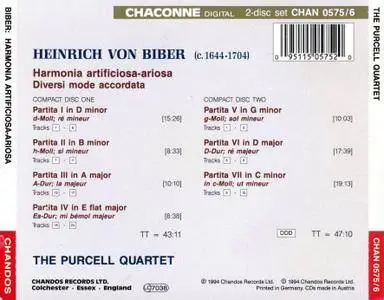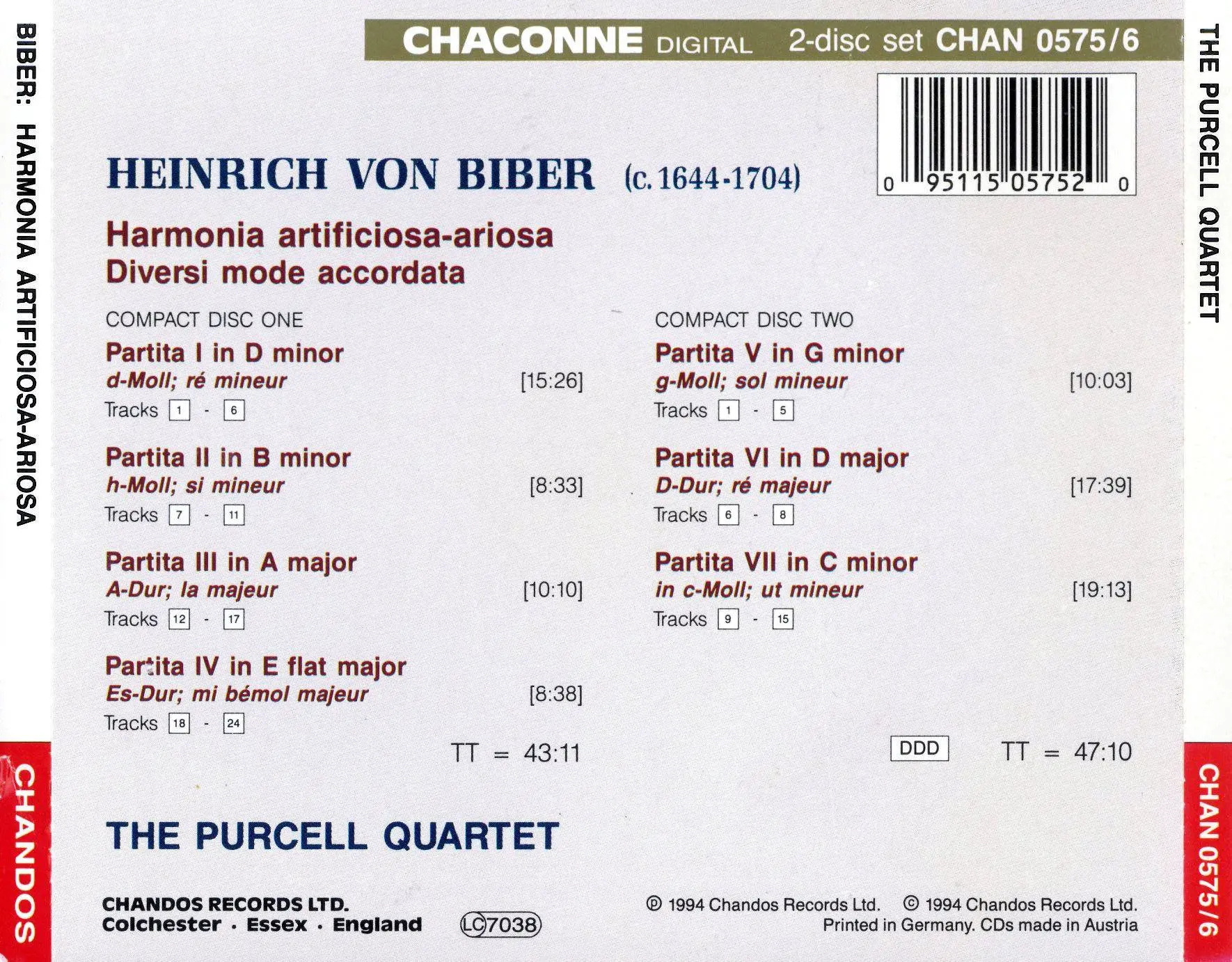Heinrich Ignaz Franz von Biber: Harmonia artificiosa ariosa (1994) 2CDs
The Purcell Quartet with Elizabeth Wallfisch (viola d`amore)
EAC | FLAC | Image (Cue&Log) ~ 429 Mb | Mp3 (CBR320) ~ 216 Mb | Scans included
Classical, Baroque | Label: Chandos | # CHAN0575/6 | Time: 01:30:22
The Purcell Quartet with Elizabeth Wallfisch (viola d`amore)
EAC | FLAC | Image (Cue&Log) ~ 429 Mb | Mp3 (CBR320) ~ 216 Mb | Scans included
Classical, Baroque | Label: Chandos | # CHAN0575/6 | Time: 01:30:22
Like many of his German and Austrian contemporaries, Bohemian-born composer Heinrich von Biber was strongly influenced by the Italian school of violin composition that included Biagio Marini (1587-1665) and Marco Uccellini (1603-1680). A noted virtuoso himself, Biber and his teacher Johann Heinrich Schmelzer (1621-1680) were two of the most important figures of the late seventeenth-century Viennese violin style. Biber's keen understanding of the technical and expressive possibilities of the instrument is evident in his innovative use of pizzicato (plucking of the string with the finger), double and triple stops (more than one note played at once creating "chords"), col legno (stick of the bow on the string), sul ponticello (played close to the bridge), and, especially, scordatura (intentional "mistuning" of the strings). Scordatura allowed the performer to play chords in particular keys more easily, extended the range of notes, and provided more open strings in order to negotiate the difficulty of polyphonic writing for a single instrument. Biber's imaginative and original use of these techniques or special effects brought violin virtuosity to an entirely new level of musical expression in the Baroque period. It can be argued that J. S. Bach's masterful Sonatas and Partitas for Solo Violin, written in 1720, are direct descendants of Biber's grounding breaking Mystery or Rosary Sonatas, composed nearly a quarter of a century earlier.
The Harmonia artificiosa-ariosa, a collection of seven partitas or suites, calls for violin, viola, and continuo (keyboardist was expected to "flesh out" or harmonize over the bass part). Technically trio sonatas, they were not published until eight years after Biber's death. Five are specifically scored for two violins, one for one violin and one viola, and one for two violas. Six of the seven partitas utilize the above-mentioned scordatura tuning, extending the potential of the instruments in terms of harmony, sonority, and technical capabilities. Imitation and counterpoint are often used. Each partita follows a similar structure: praeludium or sonata as introduction (usually improvisatory in nature or recitative-like), series of dance movements such as gigue or allamande, aria, and sets of variations. These variations presented opportunities for the kind of virtuosic fireworks and figuration that thrilled the ear. This particular format and style of composition seems to have derived from the earlier English viol or Italian viola bastarda tradition (sixteenth-century forerunners of the cello).
The Ciacona of Partita No. 3 is a delightfully crafted strict canon in unison. (Fans of Johann Pachelbel's famous Canon in D will love this.) An exciting highlight of Partita No. 6 is its aria with thirteen variations including another canon with the two upper voices only a half beat apart. Partita No. 7 is a perfect example of Biber's ability to convey a rich range of feeling while challenging the performer's technical skill. From contemplative introversion to bold abandon, each movement gives birth to a new musical experience. The drama and pathos of the Praeludium, in this final partita, are emphasized by the overriding minor tonality and autumnal quality of the two violas. (It must be noted that the use of viola as a solo instrument was unusual at this time.) Contrasting this movement is the joyful, peasant-like quality of the Terza, sounding very much like a rustic dance. The suite ends with a poignant Arietta, in this case, a set of variations over a repetitive ground bass. Full of longing and passion with flashes of brilliant bravura, it is further complicated by moments of resignation and complete calm. Infinite variety, unique inspiration, and emotional depth characterize these stunning examples of early violin repertoire from the pre-Bach era.Description by Mona DeQuis, Allmusic.com
Biber worked in an area of Europe (Bohemia) not generally associated with mainstream baroque innovation, though he made an impression on an astute Charles Burney who thought him the best violinist of the period and ''his solos the most difficult and most fanciful of any music I have seen''. Part of his fame no doubt resulted from his mastery of scordatura, a technique of re-tuning strings which enabled the violinist to play chords with greater ease than if the instrument was tuned conventionally. It also allowed certain scale degrees to be highlighted with special tonal colours, often (for example in Biber's Mystery Sonatas) as a means of emphasizing a prevailing effect. Harmonia artificiosa was posthumously published in 1712 and marks an important advance not only regarding the violinist's expressive and technical armoury, but as a means of exploring scordatura in the realms of ensemble music, an idiom (with or without scordatura) in which Biber is arguably second to none in the seventeenth century. Indeed, this collection of seven Partitas (really suites) promotes the principles of good consort writing as voraciously as it does the technique of scordatura; this is what makes the marriage between these two entwined disciplines so satisfying, as well as unique.
Not having other performances to go by (this is the first complete version on record), I am instantly struck by the Purcell Quartet's feeling for colour, very much in the way I was by John Holloway's recording of the Mystery Sonatas (Virgin, 5/91). Without colour and a highly communicative group of players this music can quickly degenerate into fare for loyal devotees only. As it is, there are some revelations here which I would recommend to anyone. The music is perhaps less consistent melodically than, say, either the consort collections, Sonatae tam aris quam aulis servientes (1676) or Fidicunium Sacro-profanum (1682 and badly in need of a good recording) and a few of the more formal dances in the first two Partitas are a touch ordinary by Biber's standards. The introspective nature of some movements should not be underestimated however: there are pieces here which draw on a type of poise similar to the English fantasia-suite tradition of Coperario and Lawes (and more directly Biber's knowledge of the English lyra viol and division techniques) which can initially be a little disconcerting if you are used to the concentrated abstract dramas which Biber cooks up in Sonatae tam aris. This is not the case in Partita No. 3 whose Praeludium is a fantastic improvisatory toccata over a pedal and the dances here seem to have a more classical Biber-like spring in their step. The playing is delightful, so rhythmically supple in the inspiring final Ciacona (Pachelbelian in ingenuity with a canon to boot), lucidly expressed and engagingly paced—as in the more austere example in Partita No. 5.
A scordatura viola replaces the second violin in Partita No. 4 and makes for some delicious coloration especially in the Aria which the Purcell Quartet play beautifully: vintage melodic Biber here. The fresh and robust view taken in the majority of pieces is largely successful, even if the harpsichord can come across as slightly relentless at times. These Partitas are of course not supposed to be heard back to back and the interchanging organ provides an adequate antidote; if the continuo sounds tame and quirkless in comparison with the violins then that has as much to do with Biber's unyielding imagination as anything else. None of this detracts from an important release of some exceptional baroque instrumental music, unavailable up to now. The collection appears to get better as it progresses: the final two works are often magical in their invention (despite a few rough edges which don't matter in the least). Partita No. 7 sports two viola d'amores in an affecting C minor, a work full of riches including another virtuosic treatment of a ground bass. I am grateful to have been introduced to these works through such committed performances.'Review by Jonathan Freeman-Attwood, Gramophone
The Purcell Quartet
with Elizabeth Wallfisch (viola d`amore)
Recorded in: St Bartholemew's Church, Orford, Suffolk 16-18 May 1994
Tracklist:
Heinrich Ignaz Franz von Biber (1644-1704)
Harmonia Artificiosa-Ariosa, partitas for strings
CD1 (43:11)
Partita I in D minor
01. I. Adagio - Presto - Adagio (3:00)
02. II. Allamande (2:00)
03. III. Gigue (4:32)
04. IV. Aria (2:10)
05. V. Sarabande - (3:11)
06. VI. Finale. Presto (0:42)
Partita II in B minor
07. I. Praeludium (2:09)
08. II. Allamande - (2:58)
09. III. Balletto. Allegro (1:03)
10. IV. Aria. Presto (0:47)
11. V. Gigue. Presto (1:43)
Partita III in A major
12. I. Praeludium. Allegro (1:32)
13. II. Allamande (1:51)
14. III. Amener. Presto (1:05)
15. IV. Balletto (0:55)
16. V. Gigue (0:41)
17. VI. Ciacona. Canon in unisono (4:14)
Partita IV in E flat major
18. I. Adagio - Allegro - Adagio (2:40)
19. II. Allamanda (1:32)
20. III. Trezza. Presto (0:53)
21. IV. Aria (1:17)
22. V. Canario (0:36)
23. VI. Gigue. Presto (1:18)
24. VII. Polcinello. Presto (0:22)
CD2 (47:11)
Partita V in G minor
01. I. Intrada. Alla breve (1:33)
02. II. Aria. Adagio - (1:32)
03. III. Balletto. Presto - (0:35)
04. IV. Gigue (0:59)
05. V. Passacaglia (5:33)
Partita VI in D major
06. I. Praeludium. Adagio - Allegro (2:54)
07. II. Aria con Variatio (13:28)
08. III. Finale. Adagio - Allegro (1:24)
Partita VII in C minor
09. I. Praeludium. Grave - Presto (3:03)
10. II. Allamande (1:50)
11. III. Sarabande (1:55)
12. IV. Gigue. Presto (2:22)
13. V. Aria (1:57)
14. VI. Trezza (0:47)
15. VII. Arietta (7:19)
Exact Audio Copy V1.0 beta 3 from 29. August 2011
EAC extraction logfile from 6. October 2012, 17:11
The Purcell Quartet / Biber - Harmonia artificiosa-ariosa - CD1
Used drive : HL-DT-STDVDRAM GSA-4083N Adapter: 1 ID: 0
Read mode : Secure
Utilize accurate stream : Yes
Defeat audio cache : Yes
Make use of C2 pointers : No
Read offset correction : 667
Overread into Lead-In and Lead-Out : No
Fill up missing offset samples with silence : Yes
Delete leading and trailing silent blocks : No
Null samples used in CRC calculations : Yes
Used interface : Native Win32 interface for Win NT & 2000
Used output format : User Defined Encoder
Selected bitrate : 896 kBit/s
Quality : High
Add ID3 tag : No
Command line compressor : C:\Program Files\Exact Audio Copy\Flac\flac.exe
Additional command line options : -V -8 %source%
TOC of the extracted CD
Track | Start | Length | Start sector | End sector
––––––––––––––––––––––––––––-
1 | 0:00.00 | 3:00.00 | 0 | 13499
2 | 3:00.00 | 2:00.00 | 13500 | 22499
3 | 5:00.00 | 4:32.00 | 22500 | 42899
4 | 9:32.00 | 2:10.00 | 42900 | 52649
5 | 11:42.00 | 3:11.00 | 52650 | 66974
6 | 14:53.00 | 0:42.00 | 66975 | 70124
7 | 15:35.00 | 2:09.00 | 70125 | 79799
8 | 17:44.00 | 2:58.00 | 79800 | 93149
9 | 20:42.00 | 1:03.00 | 93150 | 97874
10 | 21:45.00 | 0:46.42 | 97875 | 101366
11 | 22:31.42 | 1:43.33 | 101367 | 109124
12 | 24:15.00 | 1:32.00 | 109125 | 116024
13 | 25:47.00 | 1:51.00 | 116025 | 124349
14 | 27:38.00 | 1:05.00 | 124350 | 129224
15 | 28:43.00 | 0:55.22 | 129225 | 133371
16 | 29:38.22 | 0:40.53 | 133372 | 136424
17 | 30:19.00 | 4:14.00 | 136425 | 155474
18 | 34:33.00 | 2:40.00 | 155475 | 167474
19 | 37:13.00 | 1:32.00 | 167475 | 174374
20 | 38:45.00 | 0:53.00 | 174375 | 178349
21 | 39:38.00 | 1:17.00 | 178350 | 184124
22 | 40:55.00 | 0:36.00 | 184125 | 186824
23 | 41:31.00 | 1:18.00 | 186825 | 192674
24 | 42:49.00 | 0:22.30 | 192675 | 194354
Range status and errors
Selected range
Filename J:\Music\Biber - Harmonia artificioso-ariosa - The Purcell Quartet\Biber - Harmonia artificiosa-ariosa - CD1.wav
Peak level 95.1 %
Extraction speed 2.0 X
Range quality 100.0 %
Test CRC 15335161
Copy CRC 15335161
Copy OK
No errors occurred
End of status report
==== Log checksum BD215B9DEF8673B424E2080120E523A43988FE81C762985C78E1A897007F8943 ====
EAC extraction logfile from 6. October 2012, 17:11
The Purcell Quartet / Biber - Harmonia artificiosa-ariosa - CD1
Used drive : HL-DT-STDVDRAM GSA-4083N Adapter: 1 ID: 0
Read mode : Secure
Utilize accurate stream : Yes
Defeat audio cache : Yes
Make use of C2 pointers : No
Read offset correction : 667
Overread into Lead-In and Lead-Out : No
Fill up missing offset samples with silence : Yes
Delete leading and trailing silent blocks : No
Null samples used in CRC calculations : Yes
Used interface : Native Win32 interface for Win NT & 2000
Used output format : User Defined Encoder
Selected bitrate : 896 kBit/s
Quality : High
Add ID3 tag : No
Command line compressor : C:\Program Files\Exact Audio Copy\Flac\flac.exe
Additional command line options : -V -8 %source%
TOC of the extracted CD
Track | Start | Length | Start sector | End sector
––––––––––––––––––––––––––––-
1 | 0:00.00 | 3:00.00 | 0 | 13499
2 | 3:00.00 | 2:00.00 | 13500 | 22499
3 | 5:00.00 | 4:32.00 | 22500 | 42899
4 | 9:32.00 | 2:10.00 | 42900 | 52649
5 | 11:42.00 | 3:11.00 | 52650 | 66974
6 | 14:53.00 | 0:42.00 | 66975 | 70124
7 | 15:35.00 | 2:09.00 | 70125 | 79799
8 | 17:44.00 | 2:58.00 | 79800 | 93149
9 | 20:42.00 | 1:03.00 | 93150 | 97874
10 | 21:45.00 | 0:46.42 | 97875 | 101366
11 | 22:31.42 | 1:43.33 | 101367 | 109124
12 | 24:15.00 | 1:32.00 | 109125 | 116024
13 | 25:47.00 | 1:51.00 | 116025 | 124349
14 | 27:38.00 | 1:05.00 | 124350 | 129224
15 | 28:43.00 | 0:55.22 | 129225 | 133371
16 | 29:38.22 | 0:40.53 | 133372 | 136424
17 | 30:19.00 | 4:14.00 | 136425 | 155474
18 | 34:33.00 | 2:40.00 | 155475 | 167474
19 | 37:13.00 | 1:32.00 | 167475 | 174374
20 | 38:45.00 | 0:53.00 | 174375 | 178349
21 | 39:38.00 | 1:17.00 | 178350 | 184124
22 | 40:55.00 | 0:36.00 | 184125 | 186824
23 | 41:31.00 | 1:18.00 | 186825 | 192674
24 | 42:49.00 | 0:22.30 | 192675 | 194354
Range status and errors
Selected range
Filename J:\Music\Biber - Harmonia artificioso-ariosa - The Purcell Quartet\Biber - Harmonia artificiosa-ariosa - CD1.wav
Peak level 95.1 %
Extraction speed 2.0 X
Range quality 100.0 %
Test CRC 15335161
Copy CRC 15335161
Copy OK
No errors occurred
End of status report
==== Log checksum BD215B9DEF8673B424E2080120E523A43988FE81C762985C78E1A897007F8943 ====
[CUETools log; Date: 04.07.2018 15:22:17; Version: 2.1.4]
[CTDB TOCID: ocC.poMe31x09TxLMt.cKuRL6Y4-] found.
Track | CTDB Status
1 | (6/6) Accurately ripped
2 | (6/6) Accurately ripped
3 | (6/6) Accurately ripped
4 | (6/6) Accurately ripped
5 | (6/6) Accurately ripped
6 | (6/6) Accurately ripped
7 | (6/6) Accurately ripped
8 | (6/6) Accurately ripped
9 | (6/6) Accurately ripped
10 | (6/6) Accurately ripped
11 | (6/6) Accurately ripped
12 | (6/6) Accurately ripped
13 | (6/6) Accurately ripped
14 | (6/6) Accurately ripped
15 | (5/6) Accurately ripped
16 | (5/6) Accurately ripped
17 | (6/6) Accurately ripped
18 | (6/6) Accurately ripped
19 | (6/6) Accurately ripped
20 | (6/6) Accurately ripped
21 | (6/6) Accurately ripped
22 | (6/6) Accurately ripped
23 | (6/6) Accurately ripped
24 | (6/6) Accurately ripped
[AccurateRip ID: 002b136b-02ccf76b-4a0a1f18] found.
Track [ CRC | V2 ] Status
01 [4717662a|aff28475] (06+03/09) Accurately ripped
02 [566aea57|a754d00e] (06+03/09) Accurately ripped
03 [27d97bb0|27c9c2cb] (06+03/09) Accurately ripped
04 [48a447f6|a9777147] (06+03/09) Accurately ripped
05 [8f95d81d|daa1c29b] (06+03/09) Accurately ripped
06 [e069cd82|d71dd1e0] (07+03/10) Accurately ripped
07 [f7afe71c|2f51d022] (07+03/10) Accurately ripped
08 [1422f7f3|8e751efb] (07+03/10) Accurately ripped
09 [5a571cdf|baf07d5b] (06+03/09) Accurately ripped
10 [b60fe04f|4ce2f848] (07+03/10) Accurately ripped
11 [1b1ea51d|9e8fe7d8] (07+03/10) Accurately ripped
12 [25610741|d5ef5a12] (07+03/10) Accurately ripped
13 [4114886b|72c313d5] (07+03/10) Accurately ripped
14 [0399b227|6ba32b25] (07+03/10) Accurately ripped
15 [b5dde5a8|ec317321] (07+03/10) Accurately ripped
16 [11c6f709|b9957454] (07+03/10) Accurately ripped
17 [e0da4aef|60ad4cde] (07+03/10) Accurately ripped
18 [283433fc|2a2f73b2] (07+03/10) Accurately ripped
19 [3cdd872d|df5132fd] (07+03/10) Accurately ripped
20 [2557d695|a4523cb6] (07+03/10) Accurately ripped
21 [e9a6786f|1a3180d0] (07+03/10) Accurately ripped
22 [fb92eb2b|33eab4e0] (07+03/10) Accurately ripped
23 [1f7fe724|34a43390] (06+03/09) Accurately ripped
24 [236ae787|3bdb4c32] (07+03/10) Accurately ripped
Track Peak [ CRC32 ] [W/O NULL] [ LOG ]
– 95,1 [15335161] [3B9CE45E] CRC32
01 72,4 [CB192475] [5F2D4CD5]
02 62,0 [F5EB5704] [FD2DDF57]
03 68,4 [27BD280E] [D1EC5968]
04 45,1 [13DF48FA] [A45B21DD]
05 69,8 [385B8CB9] [86F4A774]
06 63,9 [7E17EF6C] [6105EC6B]
07 86,7 [3436FB3B] [7E8EA4AB]
08 63,1 [B9AB0B6A] [AA3A4F18]
09 61,9 [568E2955] [838F2264]
10 61,2 [BE7C9B2F] [CEA2E616]
11 35,4 [EE5F78E4] [0F139837]
12 83,0 [C269DF92] [1D13C03C]
13 62,2 [33FFFD22] [EEE1369C]
14 46,8 [AE2AB4AB] [854FA24E]
15 66,3 [D58A7733] [03EA0A53]
16 43,4 [4ECA2453] [C6160118]
17 70,0 [E3120ACC] [BF172360]
18 62,4 [032C2ABC] [14636E75]
19 75,9 [C086998D] [779F5DFA]
20 53,4 [7EB85BD7] [69E2C67D]
21 50,0 [171A4E26] [A7CA5EB1]
22 59,3 [6B62785D] [2C547E29]
23 95,1 [2E7541E1] [2DF96BA8]
24 66,4 [25934160] [CD241668]
[CTDB TOCID: ocC.poMe31x09TxLMt.cKuRL6Y4-] found.
Track | CTDB Status
1 | (6/6) Accurately ripped
2 | (6/6) Accurately ripped
3 | (6/6) Accurately ripped
4 | (6/6) Accurately ripped
5 | (6/6) Accurately ripped
6 | (6/6) Accurately ripped
7 | (6/6) Accurately ripped
8 | (6/6) Accurately ripped
9 | (6/6) Accurately ripped
10 | (6/6) Accurately ripped
11 | (6/6) Accurately ripped
12 | (6/6) Accurately ripped
13 | (6/6) Accurately ripped
14 | (6/6) Accurately ripped
15 | (5/6) Accurately ripped
16 | (5/6) Accurately ripped
17 | (6/6) Accurately ripped
18 | (6/6) Accurately ripped
19 | (6/6) Accurately ripped
20 | (6/6) Accurately ripped
21 | (6/6) Accurately ripped
22 | (6/6) Accurately ripped
23 | (6/6) Accurately ripped
24 | (6/6) Accurately ripped
[AccurateRip ID: 002b136b-02ccf76b-4a0a1f18] found.
Track [ CRC | V2 ] Status
01 [4717662a|aff28475] (06+03/09) Accurately ripped
02 [566aea57|a754d00e] (06+03/09) Accurately ripped
03 [27d97bb0|27c9c2cb] (06+03/09) Accurately ripped
04 [48a447f6|a9777147] (06+03/09) Accurately ripped
05 [8f95d81d|daa1c29b] (06+03/09) Accurately ripped
06 [e069cd82|d71dd1e0] (07+03/10) Accurately ripped
07 [f7afe71c|2f51d022] (07+03/10) Accurately ripped
08 [1422f7f3|8e751efb] (07+03/10) Accurately ripped
09 [5a571cdf|baf07d5b] (06+03/09) Accurately ripped
10 [b60fe04f|4ce2f848] (07+03/10) Accurately ripped
11 [1b1ea51d|9e8fe7d8] (07+03/10) Accurately ripped
12 [25610741|d5ef5a12] (07+03/10) Accurately ripped
13 [4114886b|72c313d5] (07+03/10) Accurately ripped
14 [0399b227|6ba32b25] (07+03/10) Accurately ripped
15 [b5dde5a8|ec317321] (07+03/10) Accurately ripped
16 [11c6f709|b9957454] (07+03/10) Accurately ripped
17 [e0da4aef|60ad4cde] (07+03/10) Accurately ripped
18 [283433fc|2a2f73b2] (07+03/10) Accurately ripped
19 [3cdd872d|df5132fd] (07+03/10) Accurately ripped
20 [2557d695|a4523cb6] (07+03/10) Accurately ripped
21 [e9a6786f|1a3180d0] (07+03/10) Accurately ripped
22 [fb92eb2b|33eab4e0] (07+03/10) Accurately ripped
23 [1f7fe724|34a43390] (06+03/09) Accurately ripped
24 [236ae787|3bdb4c32] (07+03/10) Accurately ripped
Track Peak [ CRC32 ] [W/O NULL] [ LOG ]
– 95,1 [15335161] [3B9CE45E] CRC32
01 72,4 [CB192475] [5F2D4CD5]
02 62,0 [F5EB5704] [FD2DDF57]
03 68,4 [27BD280E] [D1EC5968]
04 45,1 [13DF48FA] [A45B21DD]
05 69,8 [385B8CB9] [86F4A774]
06 63,9 [7E17EF6C] [6105EC6B]
07 86,7 [3436FB3B] [7E8EA4AB]
08 63,1 [B9AB0B6A] [AA3A4F18]
09 61,9 [568E2955] [838F2264]
10 61,2 [BE7C9B2F] [CEA2E616]
11 35,4 [EE5F78E4] [0F139837]
12 83,0 [C269DF92] [1D13C03C]
13 62,2 [33FFFD22] [EEE1369C]
14 46,8 [AE2AB4AB] [854FA24E]
15 66,3 [D58A7733] [03EA0A53]
16 43,4 [4ECA2453] [C6160118]
17 70,0 [E3120ACC] [BF172360]
18 62,4 [032C2ABC] [14636E75]
19 75,9 [C086998D] [779F5DFA]
20 53,4 [7EB85BD7] [69E2C67D]
21 50,0 [171A4E26] [A7CA5EB1]
22 59,3 [6B62785D] [2C547E29]
23 95,1 [2E7541E1] [2DF96BA8]
24 66,4 [25934160] [CD241668]
foobar2000 1.2 / Dynamic Range Meter 1.1.1
log date: 2018-07-04 15:27:18
––––––––––––––––––––––––––––––––––––––––
Analyzed: The Purcell Quartet / Biber - Harmonia artificiosa-ariosa - CD1
––––––––––––––––––––––––––––––––––––––––
DR Peak RMS Duration Track
––––––––––––––––––––––––––––––––––––––––
DR13 -2.80 dB -22.00 dB 3:00 01-Partita I in D minor - I. Adagio - Presto - Adagio
DR13 -4.14 dB -22.19 dB 2:00 02-Partita I in D minor - II. Allamande
DR14 -3.30 dB -22.43 dB 4:32 03-Partita I in D minor - III. Gigue
DR12 -6.91 dB -23.83 dB 2:10 04-Partita I in D minor - IV. Aria
DR14 -3.12 dB -21.43 dB 3:11 05-Partita I in D minor - V. Sarabande -
DR11 -3.89 dB -22.15 dB 0:42 06-Partita I in D minor - VI. Finale. Presto
DR14 -1.23 dB -21.91 dB 2:09 07-Partita II in B minor - I. Praeludium
DR13 -3.99 dB -21.83 dB 2:58 08-Partita II in B minor - II. Allamande -
DR14 -4.16 dB -21.28 dB 1:03 09-Partita II in B minor - III. Balletto. Allegro
DR12 -4.26 dB -21.67 dB 0:47 10-Partita II in B minor - IV. Aria. Presto
DR13 -9.00 dB -25.38 dB 1:43 11-Partita II in B minor - V. Gigue. Presto
DR11 -1.62 dB -19.32 dB 1:32 12-Partita III in A major - I. Praeludium. Allegro
DR12 -4.11 dB -21.64 dB 1:51 13-Partita III in A major - II. Allamande
DR12 -6.58 dB -21.98 dB 1:05 14-Partita III in A major - III. Amener. Presto
DR12 -3.56 dB -19.15 dB 0:55 15-Partita III in A major - IV. Balletto
DR12 -7.24 dB -22.72 dB 0:41 16-Partita III in A major - V. Gigue
DR13 -3.10 dB -21.29 dB 4:14 17-Partita III in A major - VI. Ciacona. Canon in unisono
DR12 -4.09 dB -21.31 dB 2:40 18-Partita IV in E flat major - I. Adagio - Allegro - Adagio
DR13 -2.39 dB -19.83 dB 1:32 19-Partita IV in E flat major - II. Allamanda
DR11 -5.44 dB -19.90 dB 0:53 20-Partita IV in E flat major - III. Trezza. Presto
DR12 -6.02 dB -22.10 dB 1:17 21-Partita IV in E flat major - IV. Aria
DR12 -4.53 dB -19.82 dB 0:36 22-Partita IV in E flat major - V. Canario
DR12 -0.43 dB -21.16 dB 1:18 23-Partita IV in E flat major - VI. Gigue. Presto
DR10 -3.55 dB -21.13 dB 0:22 24-Partita IV in E flat major - VII. Polcinello. Presto
––––––––––––––––––––––––––––––––––––––––
Number of tracks: 24
Official DR value: DR12
Samplerate: 44100 Hz
Channels: 2
Bits per sample: 16
Bitrate: 682 kbps
Codec: FLAC
================================================================================
log date: 2018-07-04 15:27:18
––––––––––––––––––––––––––––––––––––––––
Analyzed: The Purcell Quartet / Biber - Harmonia artificiosa-ariosa - CD1
––––––––––––––––––––––––––––––––––––––––
DR Peak RMS Duration Track
––––––––––––––––––––––––––––––––––––––––
DR13 -2.80 dB -22.00 dB 3:00 01-Partita I in D minor - I. Adagio - Presto - Adagio
DR13 -4.14 dB -22.19 dB 2:00 02-Partita I in D minor - II. Allamande
DR14 -3.30 dB -22.43 dB 4:32 03-Partita I in D minor - III. Gigue
DR12 -6.91 dB -23.83 dB 2:10 04-Partita I in D minor - IV. Aria
DR14 -3.12 dB -21.43 dB 3:11 05-Partita I in D minor - V. Sarabande -
DR11 -3.89 dB -22.15 dB 0:42 06-Partita I in D minor - VI. Finale. Presto
DR14 -1.23 dB -21.91 dB 2:09 07-Partita II in B minor - I. Praeludium
DR13 -3.99 dB -21.83 dB 2:58 08-Partita II in B minor - II. Allamande -
DR14 -4.16 dB -21.28 dB 1:03 09-Partita II in B minor - III. Balletto. Allegro
DR12 -4.26 dB -21.67 dB 0:47 10-Partita II in B minor - IV. Aria. Presto
DR13 -9.00 dB -25.38 dB 1:43 11-Partita II in B minor - V. Gigue. Presto
DR11 -1.62 dB -19.32 dB 1:32 12-Partita III in A major - I. Praeludium. Allegro
DR12 -4.11 dB -21.64 dB 1:51 13-Partita III in A major - II. Allamande
DR12 -6.58 dB -21.98 dB 1:05 14-Partita III in A major - III. Amener. Presto
DR12 -3.56 dB -19.15 dB 0:55 15-Partita III in A major - IV. Balletto
DR12 -7.24 dB -22.72 dB 0:41 16-Partita III in A major - V. Gigue
DR13 -3.10 dB -21.29 dB 4:14 17-Partita III in A major - VI. Ciacona. Canon in unisono
DR12 -4.09 dB -21.31 dB 2:40 18-Partita IV in E flat major - I. Adagio - Allegro - Adagio
DR13 -2.39 dB -19.83 dB 1:32 19-Partita IV in E flat major - II. Allamanda
DR11 -5.44 dB -19.90 dB 0:53 20-Partita IV in E flat major - III. Trezza. Presto
DR12 -6.02 dB -22.10 dB 1:17 21-Partita IV in E flat major - IV. Aria
DR12 -4.53 dB -19.82 dB 0:36 22-Partita IV in E flat major - V. Canario
DR12 -0.43 dB -21.16 dB 1:18 23-Partita IV in E flat major - VI. Gigue. Presto
DR10 -3.55 dB -21.13 dB 0:22 24-Partita IV in E flat major - VII. Polcinello. Presto
––––––––––––––––––––––––––––––––––––––––
Number of tracks: 24
Official DR value: DR12
Samplerate: 44100 Hz
Channels: 2
Bits per sample: 16
Bitrate: 682 kbps
Codec: FLAC
================================================================================
Exact Audio Copy V1.0 beta 3 from 29. August 2011
EAC extraction logfile from 6. October 2012, 17:43
The Purcell Quartet / Biber - Harmonia artificiosa-ariosa - CD2
Used drive : HL-DT-STDVDRAM GSA-4083N Adapter: 1 ID: 0
Read mode : Secure
Utilize accurate stream : Yes
Defeat audio cache : Yes
Make use of C2 pointers : No
Read offset correction : 667
Overread into Lead-In and Lead-Out : No
Fill up missing offset samples with silence : Yes
Delete leading and trailing silent blocks : No
Null samples used in CRC calculations : Yes
Used interface : Native Win32 interface for Win NT & 2000
Used output format : User Defined Encoder
Selected bitrate : 896 kBit/s
Quality : High
Add ID3 tag : No
Command line compressor : C:\Program Files\Exact Audio Copy\Flac\flac.exe
Additional command line options : -V -8 %source%
TOC of the extracted CD
Track | Start | Length | Start sector | End sector
––––––––––––––––––––––––––––-
1 | 0:00.00 | 1:32.65 | 0 | 6964
2 | 1:32.65 | 1:31.52 | 6965 | 13841
3 | 3:04.42 | 0:34.70 | 13842 | 16461
4 | 3:39.37 | 0:58.43 | 16462 | 20854
5 | 4:38.05 | 5:32.62 | 20855 | 45816
6 | 10:10.67 | 2:54.15 | 45817 | 58881
7 | 13:05.07 | 13:28.35 | 58882 | 119516
8 | 26:33.42 | 1:23.63 | 119517 | 125804
9 | 27:57.30 | 3:03.00 | 125805 | 139529
10 | 31:00.30 | 1:50.37 | 139530 | 147816
11 | 32:50.67 | 1:55.33 | 147817 | 156474
12 | 34:46.25 | 2:22.20 | 156475 | 167144
13 | 37:08.45 | 1:56.45 | 167145 | 175889
14 | 39:05.15 | 0:46.65 | 175890 | 179404
15 | 39:52.05 | 7:18.47 | 179405 | 212301
Range status and errors
Selected range
Filename J:\Music\Biber - Harmonia artificioso-ariosa - The Purcell Quartet\Biber - Harmonia artificiosa-ariosa - CD2.wav
Peak level 79.0 %
Extraction speed 4.0 X
Range quality 100.0 %
Test CRC 3F38E06B
Copy CRC 3F38E06B
Copy OK
No errors occurred
End of status report
==== Log checksum A56658C4376C9728644151CD41EF53D0229FC47F3BE7D4342C4B116A235500EA ====
EAC extraction logfile from 6. October 2012, 17:43
The Purcell Quartet / Biber - Harmonia artificiosa-ariosa - CD2
Used drive : HL-DT-STDVDRAM GSA-4083N Adapter: 1 ID: 0
Read mode : Secure
Utilize accurate stream : Yes
Defeat audio cache : Yes
Make use of C2 pointers : No
Read offset correction : 667
Overread into Lead-In and Lead-Out : No
Fill up missing offset samples with silence : Yes
Delete leading and trailing silent blocks : No
Null samples used in CRC calculations : Yes
Used interface : Native Win32 interface for Win NT & 2000
Used output format : User Defined Encoder
Selected bitrate : 896 kBit/s
Quality : High
Add ID3 tag : No
Command line compressor : C:\Program Files\Exact Audio Copy\Flac\flac.exe
Additional command line options : -V -8 %source%
TOC of the extracted CD
Track | Start | Length | Start sector | End sector
––––––––––––––––––––––––––––-
1 | 0:00.00 | 1:32.65 | 0 | 6964
2 | 1:32.65 | 1:31.52 | 6965 | 13841
3 | 3:04.42 | 0:34.70 | 13842 | 16461
4 | 3:39.37 | 0:58.43 | 16462 | 20854
5 | 4:38.05 | 5:32.62 | 20855 | 45816
6 | 10:10.67 | 2:54.15 | 45817 | 58881
7 | 13:05.07 | 13:28.35 | 58882 | 119516
8 | 26:33.42 | 1:23.63 | 119517 | 125804
9 | 27:57.30 | 3:03.00 | 125805 | 139529
10 | 31:00.30 | 1:50.37 | 139530 | 147816
11 | 32:50.67 | 1:55.33 | 147817 | 156474
12 | 34:46.25 | 2:22.20 | 156475 | 167144
13 | 37:08.45 | 1:56.45 | 167145 | 175889
14 | 39:05.15 | 0:46.65 | 175890 | 179404
15 | 39:52.05 | 7:18.47 | 179405 | 212301
Range status and errors
Selected range
Filename J:\Music\Biber - Harmonia artificioso-ariosa - The Purcell Quartet\Biber - Harmonia artificiosa-ariosa - CD2.wav
Peak level 79.0 %
Extraction speed 4.0 X
Range quality 100.0 %
Test CRC 3F38E06B
Copy CRC 3F38E06B
Copy OK
No errors occurred
End of status report
==== Log checksum A56658C4376C9728644151CD41EF53D0229FC47F3BE7D4342C4B116A235500EA ====
[CUETools log; Date: 04.07.2018 15:22:35; Version: 2.1.4]
[CTDB TOCID: Za2RfQNhErhKUB6.NDVAnE43tkY-] found.
Track | CTDB Status
1 | (6/6) Accurately ripped
2 | (6/6) Accurately ripped
3 | (6/6) Accurately ripped
4 | (6/6) Accurately ripped
5 | (6/6) Accurately ripped
6 | (6/6) Accurately ripped
7 | (6/6) Accurately ripped
8 | (6/6) Accurately ripped
9 | (6/6) Accurately ripped
10 | (6/6) Accurately ripped
11 | (6/6) Accurately ripped
12 | (6/6) Accurately ripped
13 | (6/6) Accurately ripped
14 | (6/6) Accurately ripped
15 | (5/6) Accurately ripped
[AccurateRip ID: 00183615-011c2b2c-d60b0e0f] found.
Track [ CRC | V2 ] Status
01 [3e16b73c|bf0c8f28] (06+03/09) Accurately ripped
02 [9a113f61|ab03b201] (07+03/10) Accurately ripped
03 [7ce705b1|92e821bb] (07+03/10) Accurately ripped
04 [f428b8d8|1168580c] (07+03/10) Accurately ripped
05 [f917e738|85d0413e] (07+03/10) Accurately ripped
06 [e15f12da|9770aae2] (07+03/10) Accurately ripped
07 [fe14ea68|7d86f777] (07+03/10) Accurately ripped
08 [b4292423|5155cc18] (07+03/10) Accurately ripped
09 [713de5ba|d25b346c] (07+03/10) Accurately ripped
10 [d408022c|47cb2f53] (08+03/11) Accurately ripped
11 [9dc8517c|36153d7f] (07+03/10) Accurately ripped
12 [f1e8f01c|2cdf7026] (07+03/10) Accurately ripped
13 [97c04a6a|01a8c776] (08+03/11) Accurately ripped
14 [a063492c|76cd539a] (08+03/11) Accurately ripped
15 [dd51343d|50cfbeaa] (07+03/10) Accurately ripped
Track Peak [ CRC32 ] [W/O NULL] [ LOG ]
– 79,0 [3F38E06B] [FD54729F] CRC32
01 59,8 [40C66C31] [4C8676CA]
02 39,0 [BF85FCD7] [67E7986A]
03 53,3 [FFEC509F] [59DD4438]
04 42,1 [F460F0E3] [466D08E4]
05 51,5 [DF5969F2] [E073529C]
06 59,5 [8643341E] [C81FC1B2]
07 75,7 [94CBFB33] [FD7AA0BC]
08 72,9 [5A1B3FF4] [9574E7DA]
09 66,7 [90901F43] [02C165FD]
10 53,2 [BCAA9E0A] [19363B1F]
11 63,7 [D80B51FF] [7688C3BC]
12 45,3 [9D9F4532] [A2784BBC]
13 62,6 [02564212] [574F30A1]
14 70,5 [E0ED347E] [95BD60E7]
15 79,0 [3A9E824E] [D70415F0]
[CTDB TOCID: Za2RfQNhErhKUB6.NDVAnE43tkY-] found.
Track | CTDB Status
1 | (6/6) Accurately ripped
2 | (6/6) Accurately ripped
3 | (6/6) Accurately ripped
4 | (6/6) Accurately ripped
5 | (6/6) Accurately ripped
6 | (6/6) Accurately ripped
7 | (6/6) Accurately ripped
8 | (6/6) Accurately ripped
9 | (6/6) Accurately ripped
10 | (6/6) Accurately ripped
11 | (6/6) Accurately ripped
12 | (6/6) Accurately ripped
13 | (6/6) Accurately ripped
14 | (6/6) Accurately ripped
15 | (5/6) Accurately ripped
[AccurateRip ID: 00183615-011c2b2c-d60b0e0f] found.
Track [ CRC | V2 ] Status
01 [3e16b73c|bf0c8f28] (06+03/09) Accurately ripped
02 [9a113f61|ab03b201] (07+03/10) Accurately ripped
03 [7ce705b1|92e821bb] (07+03/10) Accurately ripped
04 [f428b8d8|1168580c] (07+03/10) Accurately ripped
05 [f917e738|85d0413e] (07+03/10) Accurately ripped
06 [e15f12da|9770aae2] (07+03/10) Accurately ripped
07 [fe14ea68|7d86f777] (07+03/10) Accurately ripped
08 [b4292423|5155cc18] (07+03/10) Accurately ripped
09 [713de5ba|d25b346c] (07+03/10) Accurately ripped
10 [d408022c|47cb2f53] (08+03/11) Accurately ripped
11 [9dc8517c|36153d7f] (07+03/10) Accurately ripped
12 [f1e8f01c|2cdf7026] (07+03/10) Accurately ripped
13 [97c04a6a|01a8c776] (08+03/11) Accurately ripped
14 [a063492c|76cd539a] (08+03/11) Accurately ripped
15 [dd51343d|50cfbeaa] (07+03/10) Accurately ripped
Track Peak [ CRC32 ] [W/O NULL] [ LOG ]
– 79,0 [3F38E06B] [FD54729F] CRC32
01 59,8 [40C66C31] [4C8676CA]
02 39,0 [BF85FCD7] [67E7986A]
03 53,3 [FFEC509F] [59DD4438]
04 42,1 [F460F0E3] [466D08E4]
05 51,5 [DF5969F2] [E073529C]
06 59,5 [8643341E] [C81FC1B2]
07 75,7 [94CBFB33] [FD7AA0BC]
08 72,9 [5A1B3FF4] [9574E7DA]
09 66,7 [90901F43] [02C165FD]
10 53,2 [BCAA9E0A] [19363B1F]
11 63,7 [D80B51FF] [7688C3BC]
12 45,3 [9D9F4532] [A2784BBC]
13 62,6 [02564212] [574F30A1]
14 70,5 [E0ED347E] [95BD60E7]
15 79,0 [3A9E824E] [D70415F0]
foobar2000 1.2 / Dynamic Range Meter 1.1.1
log date: 2018-07-04 15:27:41
––––––––––––––––––––––––––––––––––––––––
Analyzed: The Purcell Quartet / Biber - Harmonia artificiosa-ariosa - CD2
––––––––––––––––––––––––––––––––––––––––
DR Peak RMS Duration Track
––––––––––––––––––––––––––––––––––––––––
DR13 -4.46 dB -21.92 dB 1:33 01-Partita V in G minor - I. Intrada. Alla breve
DR11 -8.16 dB -23.56 dB 1:32 02-Partita V in G minor - II. Aria. Adagio -
DR12 -5.45 dB -21.62 dB 0:35 03-Partita V in G minor - III. Balletto. Presto -
DR11 -7.50 dB -25.01 dB 0:59 04-Partita V in G minor - IV. Gigue
DR12 -5.76 dB -21.57 dB 5:33 05-Partita V in G minor - V. Passacaglia
DR11 -4.50 dB -21.03 dB 2:54 06-Partita VI in D major - I. Praeludium. Adagio - Allegro
DR13 -2.41 dB -21.31 dB 13:28 07-Partita VI in D major - II. Aria con Variatio
DR11 -2.74 dB -22.22 dB 1:24 08-Partita VI in D major - III. Finale. Adagio - Allegro
DR11 -3.52 dB -18.90 dB 3:03 09-Partita VII in C minor - I. Praeludium. Grave - Presto
DR11 -5.48 dB -19.55 dB 1:50 10-Partita VII in C minor - II. Allamande
DR11 -3.91 dB -20.31 dB 1:55 11-Partita VII in C minor - III. Sarabande
DR12 -6.88 dB -23.66 dB 2:22 12-Partita VII in C minor - IV. Gigue. Presto
DR12 -4.06 dB -20.13 dB 1:57 13-Partita VII in C minor - V. Aria
DR11 -3.03 dB -17.64 dB 0:47 14-Partita VII in C minor - VI. Trezza
DR13 -2.04 dB -20.90 dB 7:19 15-Partita VII in C minor - VII. Arietta
––––––––––––––––––––––––––––––––––––––––
Number of tracks: 15
Official DR value: DR12
Samplerate: 44100 Hz
Channels: 2
Bits per sample: 16
Bitrate: 621 kbps
Codec: FLAC
================================================================================
log date: 2018-07-04 15:27:41
––––––––––––––––––––––––––––––––––––––––
Analyzed: The Purcell Quartet / Biber - Harmonia artificiosa-ariosa - CD2
––––––––––––––––––––––––––––––––––––––––
DR Peak RMS Duration Track
––––––––––––––––––––––––––––––––––––––––
DR13 -4.46 dB -21.92 dB 1:33 01-Partita V in G minor - I. Intrada. Alla breve
DR11 -8.16 dB -23.56 dB 1:32 02-Partita V in G minor - II. Aria. Adagio -
DR12 -5.45 dB -21.62 dB 0:35 03-Partita V in G minor - III. Balletto. Presto -
DR11 -7.50 dB -25.01 dB 0:59 04-Partita V in G minor - IV. Gigue
DR12 -5.76 dB -21.57 dB 5:33 05-Partita V in G minor - V. Passacaglia
DR11 -4.50 dB -21.03 dB 2:54 06-Partita VI in D major - I. Praeludium. Adagio - Allegro
DR13 -2.41 dB -21.31 dB 13:28 07-Partita VI in D major - II. Aria con Variatio
DR11 -2.74 dB -22.22 dB 1:24 08-Partita VI in D major - III. Finale. Adagio - Allegro
DR11 -3.52 dB -18.90 dB 3:03 09-Partita VII in C minor - I. Praeludium. Grave - Presto
DR11 -5.48 dB -19.55 dB 1:50 10-Partita VII in C minor - II. Allamande
DR11 -3.91 dB -20.31 dB 1:55 11-Partita VII in C minor - III. Sarabande
DR12 -6.88 dB -23.66 dB 2:22 12-Partita VII in C minor - IV. Gigue. Presto
DR12 -4.06 dB -20.13 dB 1:57 13-Partita VII in C minor - V. Aria
DR11 -3.03 dB -17.64 dB 0:47 14-Partita VII in C minor - VI. Trezza
DR13 -2.04 dB -20.90 dB 7:19 15-Partita VII in C minor - VII. Arietta
––––––––––––––––––––––––––––––––––––––––
Number of tracks: 15
Official DR value: DR12
Samplerate: 44100 Hz
Channels: 2
Bits per sample: 16
Bitrate: 621 kbps
Codec: FLAC
================================================================================


